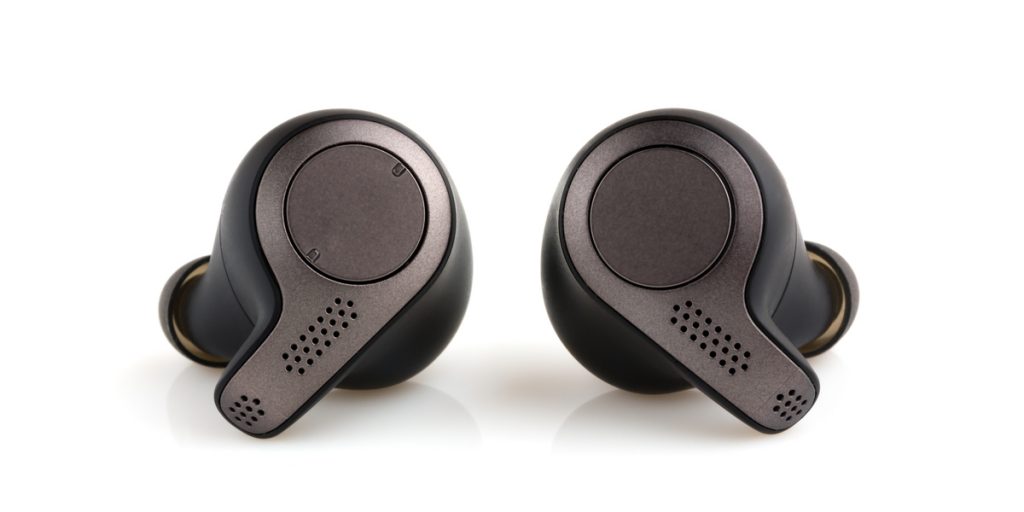Bluetooth radiation is one of the least discussed forms of electromagnetic fields. The lack of any formal studies has led industry “experts” to conclude that they are safe.
This claim is not based on any evidence proving that they are harmless, but rather on the lack of research proving that they are unsafe. This, however, is changing fast.
With Bluetooth headset sales through the roof, consumers are now concerned about how safe they are for long term use. While wireless technology is fast becoming the trend, there are lots of risks associated with the EMF emissions they produce. This guide explores whether Bluetooth headphones are safe for long term usage.
You might also be interested in our article on the radiation by fitbit devices.
What are Bluetooth Headphones?

Bluetooth headsets are earbuds that mimic miniature Wi-Fi routers. These hands-free devices use radio waves instead of cables to connect to a smartphone, cell phone, or PC.
They were designed with aesthetics in mind to get rid of unsightly wires that were previously the only way you could connect headphones to other devices. They have a mouthpiece and earpiece that allow you to speak and hear through them without having to hold them.
Recommended EMF Protection Products
- TriField EMF Meter Model TF2 (Amazon) – measures the 3 different types of EMF radiation, including RF radiation from routers and cell phones
- Wifi Router Guard Cover (Amazon) – blocks up to 90% of EMF radiation from router using a Faraday cage
- Smart Meter Guard Cover (Amazon) – blocks up to 98% of EMF radiation emitted from your smart meter
- EMF Protection Underwear for Men & Women – Lambs uses WaveStopper technology to block 99% of UV and Wireless Radiation.
- EMF Protection T-Shirts for Men & Women – Lambs independently lab tested material blocks 99% of UV and Wireless Radiation
How Bluetooth Works
Bluetooth technology dates back to 1998, with the first headset being developed two years later. When a Bluetooth device is connected, it becomes part of a localized wireless network.
The headphones act as both the receiver and transmitter of the wireless signal. But what makes Bluetooth signals different from other wireless signals?
For starters, the radio waves that transmit signals to and from your phone are configured using complex algorithms to ensure that speech is sent clearly and crisply to the microphone. They also ensure that sounds coming into your ear from your phone are equally as clear.
Additionally, while multiple Bluetooth devices can connect to a single parent phone, these devices cannot communicate with each other. They can only send and transmit signals through the parent phone. This configuration also limits the number of peripheral devices that can connect to a master.
For a Bluetooth headphone to be able to communicate with its master device, the two need to pair. Pairing is the process where an information link is created to connect a Bluetooth peripheral to its parent device. This could be a smartphone, cell phone, or PC.
For this to work, both devices must have the pairing setting turned on, and both gadgets have to be discoverable on the network. The headsets then generate a PIN or password that has to be entered in the master device to activate pairing.
Do Bluetooth Headphones Emit Radiation?
Most Bluetooth headphones are Class 2 devices. A Bluetooth class determines the wireless range of the device. Class 1 devices have a range that extends up to 300 feet, whereas Class 2 devices have a 30-foot radius.
Connectivity also depends on other factors like the battery conditions, antenna configuration, material coverage, and whether the existing conditions are conducive for propagation.
Bluetooth headphones emit the same radiofrequency (RF) radiation as that of microwaves. Of course, the wattage is different, but it’s the same kind of EMF. It’s also the same type of radiation that cell phones emit, albeit at slightly different frequencies as microwaves and Bluetooth waves.
The “official” word from regulatory authorities on the safety of Bluetooth headphones is that the amount of radiation they emit is too low to be considered a threat to human health. However, if you think about it, this claim is flawed, considering that you essentially have RF microwave radiation directly against your body at the 2.4GHz to 2.4835 GHz range for long periods.
RF frequencies are classified as low-energy emissions. But, a lot of recent research proves that even at these low levels, RF radiation is still capable of inducing a host of adverse effects on human biological systems. Some of these include neurological damage and DNA fragmentation.
In the same breath, consider where Bluetooth headphones are most of the time. You place them directly in your ear. This means that even if Bluetooth devices operate at lower radiation intensities, the contact time between the EMF and your brain tissue is elevated. This is way higher than the time spent holding your cell phone up to your ear.
Dangers of Bluetooth EMF Radiation Exposure to Your Head

Have you ever stopped to think about the contents of your head? It makes for the perfect antenna since it is filled with lots of salty fluid and conductive tissue, which are ideal for sending and receiving electrochemical signals.
It also makes them susceptible to disruption by electromagnetic fields more so if you have an RF radiating device superficially implanted to the side of your head. Here are a few of the dangers that long term usage of Bluetooth headphones exposes you to.
Headaches
One of the most frequently asked questions by users on online forums has to be whether there’s a link between the Bluetooth headsets they wear and the headaches that ensue a while later. This is not a coincidence.
One of the characteristics of EMF radiation exposure that emanates from wearing Bluetooth headphones for too long are the neuropsychiatric effects they induce. Some of these have been linked to depression. Here’s why:
- EMF radiation activates (VGCC) Voltage-Gated Calcium Ion Channels in the brain. These are responsible for enabling neurological communication between brain cells.
- Activation of VGCC is responsible for a host of different neuropsychiatric effects.
ADHD
Recent studies have also linked Attention Deficit Hyperactivity Disorder (ADHD) to high levels of EMF radiation exposure like that emitted by Bluetooth headsets. The fields cause calcium to leak into brain cells, making them hypersensitive and more likely to transmit specious signals. The effects of this include:
- Triggering random thoughts
- Clouding mental activity
- Loss of concentration
RF radiation exposure to children is especially dangerous since their brains are still developing. So, if you got your child a pair of Bluetooth headphones, it’s in their best interest for you to confiscate them.
Biological Effects
Weak electromagnetic fields have short wavelengths. Bluetooth waves fall in this category. They rise and fall rapidly, creating pulses that are damaging to human cells.
They throw off calcium ion signaling, which inevitably causes their channels to leak. Long term exposure disrupts the tissues at a cellular level and causes irreversible damage to DNA. This ultimately increases the risk of cancer.
What’s more, because Bluetooth radiation exposure is so close to the head, it thins out and weakens the blood-brain barrier which makes the neurons vulnerable to damage.
Tinnitus
Tinnitus is a condition where an individual perceives ringing or noise in the ears. It affects approximately 20% of the population.
A Brazilian study found that EMF RF radiation triggers the onset of the condition or worsens it in those who already have it. In normal cases where it is not EMF-induced, Tinnitus is usually an underlying condition brought on by a disorder in the circulatory system, an ear injury or age-related hearing loss.
Bluetooth Headphone Alternatives

Bluetooth headphones are a convenient hands-free option when you’re working out, driving or if you just don’t want to get bogged-down by cables hanging from your ears. Nonetheless, you need to consider their potential adverse effects on your health.
To avoid the risks described in the previous section, there are safer alternatives that keep you relatively safe from harmful Bluetooth EMF RF emissions. Here are some of them.
Good Old-Fashioned Wired Headphones
Wired headphones work by being plugged into a signal source, which could be your smartphone or radio. The sound signal is converted into an electrical signal and is conducted through the cable up to the earpiece in your ear. The electric signal is then converted to an acoustic tone, which is released through the earphone speaker.
As is the case with all electrical signals, EMF radiation is present in the source-to-ear process. Its intensity is what makes all the difference. Since it is confined, it’s less damaging than an airborne Bluetooth signal.
Air Tube Headphones
Air tube headphones are 100% EMF radiation-free. Unlike traditional headphones where the speakers are located right against the ear, air tube headphones have their speakers located far from the head.
The electrical signal from the source is converted into an acoustic tone. This then travels up a flexible hollow air tube to the earbuds which don’t have any metal conductor. This makes them free from all forms of EMF radiation.
Here’s an article on the best Airtube Headsets and Headphones.
Ditch the Bluetooth Headphones
Unlike most of the other sources of involuntary EMF radiation you’re exposed to daily, you have control over what’s emanating from your headphones. All you have to do is ditch the devices altogether and use speakers instead!
If you switch to wired or air tube headphones, ensure that you watch out for immediate health risks than a theoretic tumor somewhere down the road. A prime example of this is stepping into oncoming traffic because you’re distracted by the music blasting out of your radiation-free headphones. Not sure if the cell tower near you can cause health problems? Check out our blog to find out the truth.
References
Pall, M. Wi-Fi is an important threat to human health. Environmental Research. Volume 164, July 2018, pages 405-416
Miller, A. B., Sears, M. E., Morgan, L. L., Davis, D. L., Hardell, L., Oremus, M., & Soskolne, C. L. (2019). Risks to Health and Well-Being From Radio-Frequency Radiation Emitted by Cell Phones and Other Wireless Devices. Frontiers in public health, 7, 223. doi:10.3389/fpubh.2019.00223
Sage C. & Burgio, E. Electromagnetic Fields, Pulsed Radiofrequency Radiation, and Epigenetics: How Wireless Technologies May Affect Childhood Development. Child Dev. 2018 Jan;89(1):129-136.
Desai, N. R., Kesari, K. K., & Agarwal, A. (2009). Pathophysiology of cell phone radiation: oxidative stress and carcinogenesis with
Medeiros LN & Sanchez TG. Tinnitus and cell phones: the role of electromagnetic radiofrequency radiation. Braz J Otorhinolaryngol. 2016 Jan-Feb;82(1):97-104. doi: 10.1016/j.bjorl.2015.04.013. Epub 2015 Sep 21.


